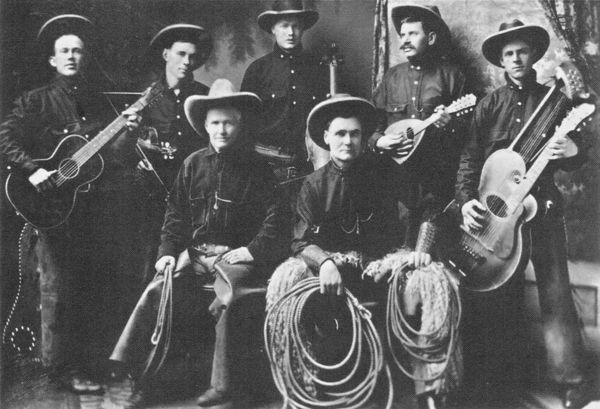Annotation:Cowboy's Dream (2)
X:1 T:Cowboy's Dream [2] S:McGinty's Oklahoma Cowboy Band M:C| L:1/8 D:OKeh 45057 (78 RPM), McGinty's Oklahoma Cow Boy Band (1926) N:Otto Gray was listed as "Director" of the band on the recording. F:https://www.slippery-hill.com/recording/cowboys-dream-0 Z:Transcribed by Andrew Kuntz K:D FE|D2 FA d2 (3DEF|G2B2 edcB|ABce a2c2|edcB AGFE| D2 FA d2 (3DEF|G2B2 edcB|ABce a2c2|[F2d2][Fd][Fd] [F2d2]:| [A3f3]f g2b2|a4d3d|c2[c2a2]c2 [c2a2]|fgfe dB A2| [A3f3]f g2b2|a4d3d|c2[c2a2]c2 [c2a2]|fgfe d4:|]
COWBOY'S DREAM [2]. American, Reel (cut time). D Major. Standard tuning (fiddle). AABB. A signature tune from Otto Gray and His Oklahoma Cowboys [1], recorded for OKeh records in 1926. The band was the first nationally famous cowboy music band, whose members were, at the beginning, actual working cowboys from the ranches around Ripley, Payne County, north-central Oklahoma. The group was formed in the 1920's by Billy McGinty, a former Rough Rider and alumnus of Buffalo Bill Cody's Wild West traveling spectacle. Otto Gray (1884-1967) took over when McGinty became a postmaster of Ripley, and, as the group became more popular and traveled more, the other original members dropped out. They were replaced by professional musicians and the group continued to record, broadcast over the radio and play vaudeville stages in the Midwest and Northeast. They disbanded in the early 1930's, victims of the Great Depression, like so many other similar string bands.

